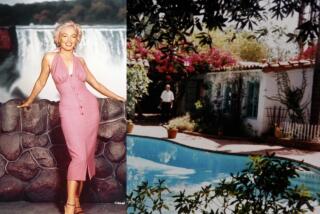BOYLE HEIGHTS : Group Works to Save Chinese Shrine
Every time Randall Bloch visits the corner of Evergreen Cemetery where a historic Chinese cemetery shrine stands, he becomes more discouraged.
The shrine, twin furnaces and the remains of a stone altar built to honor the dead and send them on to the next world, was built in 1888. The cemetery’s owners were going to bulldoze it to make way for new graves when Bloch learned of the plan and notified the Chinese Historical Society of Southern California.
The society persuaded the city in 1990 to designate the site as a historical monument, protecting it for one year. Last year, the society bought the site and 42 surrounding graves for $14,000, half of owner S. F. Montgomery’s original asking price.
But the toughest task of preserving the monument may lie ahead. The society is raising money to protect the shrine with a retaining wall, preserve what is left of it and then restore it.
“I’m very concerned that the monument continues to deteriorate,” Bloch told the city’s Cultural Arts Planning Commission in a meeting Wednesday at the Boyle Heights Senior Citizens Center. “I’m concerned that every time I go out there, I notice a little more crumbling of the monument and a little more graffiti and beer bottles.”
Bloch had come to the meeting with other members of the historical society to plead for money for the preservation project, but commission members said they had none to give.
The society has raised $7,000 in private donations and estimates the work will cost $45,000 to $50,000.
The shrine has not been used for ceremonial purposes since 1965, but held a sacred significance to the city’s Chinese community when it was built, said Irvin Lai, a member of the historical society board of directors and past national president of the Chinese-American Citizens Alliance.
The 80-acre Evergreen Cemetery was founded in 1877 and contains the graves of naturalist John Muir and Biddy Mason, a slave who was freed in California and is one of founders of Los Angeles’ First African Methodist Episcopal Church. The section that contains the shrine was used to bury indigents: Chinese-Americans were charged $10; everyone else was buried free.
In a ceremony that dates back centuries, relatives and friends of the deceased would burn incense and offer roasted pig, chicken, Chinese tea cakes and other food and wine on the altar to the spirits.
“They opened the (furnace) door and burned paper money and burned their clothing and a paper television or a paper car,” Lai said.
After the ceremony, the family would eat the food. Every year, they would return on a special day to clean the grave site, plant flowers and remember their loved ones.
The shrine is significant because it is the earliest evidence of a Chinese community in Los Angeles, said Sue Ellen Cheng, curator of El Pueblo Historic Monument, which has plans for a Museum of Chinese American History at the Garnier Building on Olvera Street.
In addition to raising private funds, the historical society has applied for cultural arts and other grants in the hope of alerting others to the significance of the shrine.
More to Read
Sign up for Essential California
The most important California stories and recommendations in your inbox every morning.
You may occasionally receive promotional content from the Los Angeles Times.










